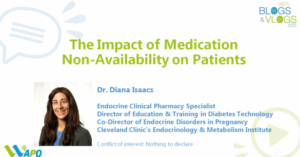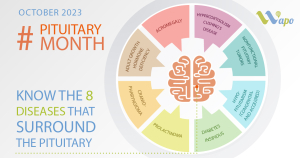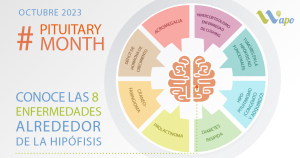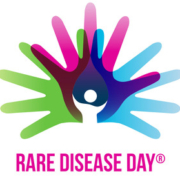Nos complace presentar la nueva edición 2025 de Blogs y Vlogs de WAPO que incluirá una entrevista en vídeo y un artículo en el blog en el que se destacan los puntos clave y proporciona recursos adicionales para aprender sobre el tema.
En nuestra primera entrega tenemos el honor de presentar a Johan G. Beun, embajador de AdrenalNet (BijnierNET en holandés). Johan comparte su experiencia sobre el tema del empleo y los retos a los que se enfrentan las personas que viven con insuficiencia suprarrenal o con un trastorno hipofisario, a raíz de un proyecto holandés en el que participan múltiples partes interesadas. Este artículo ofrece un resumen de la entrevista en Vlog que puede encontrar en la Biblioteca del sitio web y el canal de YouTube de WAPO.
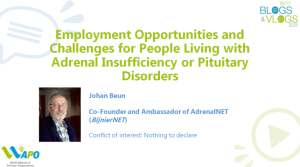
¿Qué es AdrenalNet y Adrenals.eu?
AdrenalNet (BijnierNET) fue fundada en 2015 en los Países Bajos por los seis centros médicos universitarios, dos organizaciones de pacientes y la Sociedad Holandesa de Endocrinología (NVE). Se creó para abordar la falta de información disponible sobre las afecciones suprarrenales en los Países Bajos. En este país, unas 12.000 a 14.000 personas utilizan hidrocortisona, la mayoría de las cuales son pacientes suprarrenales. AdrenalNet reconoció que la creación de un sitio web de información único, completo y de alta calidad sería más eficaz que el hecho de que cada hospital desarrollara sus propios recursos. Aunque inicialmente se centró en los Países Bajos, AdrenalNet recibió solicitudes de información de otros países, en particular de Escandinavia, donde ya colaboraba estrechamente con la organización danesa de pacientes suprarrenales (Addison Foreningen Danmark). Otras consultas procedían de Alemania, Bélgica, Francia y lugares más lejanos como Canadá, Australia, Nueva Zelanda, Tailandia y Singapur. En la actualidad, AdrenalNet (www.BijnierNET.nl ) recibe al menos 15.000 visitantes únicos al mes, mientras que adrenals.eu (el sitio web internacional) recibe unos 7.500.
¿Cuáles son los retos más comunes a los que se enfrentan las personas con insuficiencia suprarrenal o con un trastorno hipofisario en términos de empleo?
Johan reconoció la complejidad y gravedad de los retos a los que se enfrentan los pacientes con insuficiencia suprarrenal o trastornos hipofisarios a la hora de encontrar empleo. Señaló la prevalencia de “normas de pseudoprivacidad” y la tendencia de los profesionales a trabajar en silos. Por ejemplo, muchos médicos pasan a desempeñar funciones relacionadas con los seguros y hay endocrinólogos que evitan comunicarse con los expertos en seguros, dejando a los pacientes a oscuras con respecto al proceso global.
Subrayó que esta falta de coordinación afecta a diversos profesionales, desde médicos generalistas y de salud laboral hasta especialistas en medicina interna. Aunque todos estos profesionales tienen buenas intenciones, la realidad es que el sistema le suele fallar a los pacientes, quienes luego se quedan sin el apoyo que necesitan. Esta falta de colaboración centrada en el paciente conduce a procesos diagnósticos subóptimos, diagnósticos tardíos y tratamientos inadecuados. Las mujeres también se enfrentan a retos adicionales debido a los prejuicios sexistas, ya que a menudo se las descarta con explicaciones como “serán sus hormonas” o “¿no está ya menopáusica?”, lo que provoca retrasos a la hora de recibir una atención adecuada.
En los Países Bajos, otro problema es el plazo de 24 meses para hacer un diagnóstico y establecer un plan de tratamiento a fin de poder optar a programas de rehabilitación y planes de seguro. Por desgracia, este plazo suele ser demasiado corto, lo que crea problemas para los pacientes, tanto físicos como económicos.
Johan también mencionó los problemas psicológicos que a menudo no se abordan. Muchas personas dudan en buscar ayuda para los efectos de su enfermedad en la salud mental. Johan defendió la necesidad de un enfoque más integrado que combine el empleo, la asistencia sanitaria y el apoyo a la salud mental. Subrayó que estos tres elementos deben trabajar juntos para garantizar que se satisfagan las necesidades físicas, emocionales y profesionales del paciente.
¿Puede hablarnos brevemente del proyecto holandés de “Participación en el empleo” en el que participó y cuáles fueron sus principales conclusiones y resultados?
Esta iniciativa comenzó como un proyecto de investigación exploratoria destinado a comprender cómo se entrecruzan la asistencia sanitaria y la participación laboral, y dónde se plantean los retos.
A pesar de funcionar con un presupuesto muy limitado, dio lugar a resultados significativos, en gran parte gracias al entusiasmo y la colaboración de sus participantes. El proyecto reunió a un grupo diverso de profesionales y partes interesadas, entre ellos expertos laborales, médicos de seguros, pacientes, defensores de pacientes, endocrinólogos, especialistas en rehabilitación, fisioterapeutas y enfermeras. Sus puntos de vista compartidos revelaron la importancia de la colaboración y el intercambio de conocimientos. Johan lo describió como un cuadro en el que todos los expertos aportan un color, pero la obra de arte final es una hermosa mezcla de todos estos colores.

Para las personas con enfermedades raras como la insuficiencia suprarrenal, los obstáculos adicionales, como las restricciones de privacidad, las lagunas de conocimientos y el retraso en el diagnóstico, no hacen sino amplificar los retos. Esto subraya la urgente necesidad de compartir más conocimientos y colaborar entre disciplinas para ayudar mejor a estos pacientes tanto en el ámbito sanitario como laboral.
Johan compartió cómo los tiempos de diagnóstico de las enfermedades suprarrenales han mejorado significativamente con los años. Cuando empezó a trabajar en el sector sanitario, los pacientes podían tardar hasta 25 años en recibir un diagnóstico. Actualmente el tiempo medio oscila entre un año a dos y medio, lo que sigue siendo demasiado, aunque haya mejorado. Insistió en la necesidad de compartir conocimientos y hacer que la información sanitaria sea neutral y accesible. Esta reflexión inspiró la creación de las siguientes cartillas durante el transcurso del proyecto:
CARTILLA INFORMATIVA sobre el Síndrome de Cushing
CARTILLA INFORMATIVA sobre los Trastornos Hipofisarios
CARTILLA INFORMATIVA sobre la Insuficiencia Suprarrenal (disponible en breve – añadir enlace)
Johan mencionó el impacto positivo que ya han tenido estas cartillas. Han permitido a todos los médicos, expertos en seguros, expertos laborales y expertos en rehabilitación comprender realmente la esencia de las distintas enfermedades. Johan explicó que el proyecto eliminó las barreras habituales, lo que permitió al grupo colaborar en la creación de los elementos básicos de estas cartillas. Para Johan, la creación de información sanitaria fiable, neutral y exhaustiva es esencial para mejorar la vida de los pacientes suprarrenales e hipofisarios.
¿Cómo pueden contribuir los profesionales sanitarios a reducir la incapacidad laboral y prevenir el desempleo?
Johan explicó que la cuestión del trabajo y la enfermedad es compleja porque los empresarios suelen contratar a empleados para que trabajen a cambio de dinero. Sin embargo, el trabajo no consiste sólo en ganar dinero, sino que es parte integrante de la vida de una persona. Mucha gente disfruta con su trabajo, establece vínculos sociales a través de él y se siente orgullosa de lo que hace.
Hizo hincapié en que, aunque una persona con insuficiencia suprarrenal o un trastorno hipofisario pueda no ser un “empleado perfecto” en términos tradicionales, sigue teniendo muchas capacidades valiosas que ofrecer. En lugar de centrarnos en lo que una persona no puede hacer, deberíamos centrarnos en lo que todavía puede aportar, tanto a la sociedad como a su empleador.
Hizo hincapié en la necesidad de flexibilidad en el lugar de trabajo, rechazando el pensamiento de “o uno es bueno para trabajar o no lo es”. Señaló que la mayoría de las personas, incluso quienes se enfrentan a una enfermedad rara, son capaces de trabajar en alguna capacidad.
Por desgracia, con demasiada frecuencia los pacientes se ven atrapados en un ciclo en el que los profesionales sanitarios y las empresas se centran en el seguro y los aspectos financieros, en lugar de tener en cuenta el bienestar a largo plazo del paciente. Para Johan, el objetivo debe ser que los profesionales sanitarios den prioridad “a la salud y el bienestar del paciente a largo plazo”, asegurándose de que pueda seguir participando en la vida laboral al tiempo que controla adecuadamente su enfermedad.

¿Qué medidas prácticas pueden adoptar los empleadores para apoyar mejor a los empleados que padecen alguna de estas enfermedades?
Johan compartió su perspectiva como alguien que ha experimentado diferentes roles como empresario, empleado y ahora, como “jubilado en formación”. Admitió que aún no ha abrazado plenamente su jubilación, pues le encanta trabajar.
Destacó la necesidad de informar mejor a los empresarios sobre cómo pueden apoyar a los empleados con insuficiencia suprarrenal o un trastorno hipofisario. Proporcionando flexibilidad y realizando ajustes (como permitir a los empleados trabajar desde casa, si fuese apropiado) se anima a los pacientes a seguir conectados a su trabajo y a seguir contribuyendo. En su opinión, tener un empleo, incluso en una capacidad reducida, es esencial para la sensación de propósito y bienestar del empleado.
Johan también se refirió a los retos del sistema holandés, en el que las discusiones suelen centrarse en los ingresos, el seguro médico y el seguro del empleador. En su opinión, hay que dejar de centrarse en consideraciones puramente financieras y centrarse en la felicidad y el bienestar general del empleado. Sugirió que las empresas podrían recibir información periódica sobre el estado de salud y la evolución de sus empleados, de modo que las decisiones se tomen teniendo en cuenta el interés superior del paciente, en lugar de centrarse únicamente en cuestiones económicas.
¿Qué deben tener en cuenta las personas a las que se acaba de diagnosticar una de estas afecciones en relación con su carrera profesional, así como para mantener un equilibrio saludable entre la vida laboral y personal?
Johan sugirió 5 elementos a tener en cuenta al momento de abordar esta cuestión:
1) Los retrasos en el diagnóstico son frecuentes en las enfermedades hipofisarias y suprarrenales. Si teme estar siendo atendido en un hospital en el que faltan los conocimientos adecuados, debe intentar buscar atención en hospitales con experiencia en estas afecciones para poder tener un diagnóstico a tiempo. En los Países Bajos hay aproximadamente 70 u 80 hospitales y sólo entre del 10 al 30% de estos cuentan con endocrinólogos expertos en estas afecciones. Es fundamental aceptar la posibilidad de que en su ciudad no haya un hospital con expertos en su enfermedad y tendrá que estudiar las opciones para acceder a la atención de expertos.
2) Hable con su médico de cabecera y su endocrinólogo, y compártales sus preocupaciones en lo que respecta al tratamiento. Pregúnteles sobre sus experiencias, especialmente en lo que se refiere a la cirugía de la pituitaria. Según Johan, este tipo de cirugías requieren “expertos super especializados” y sólo deberían realizarse en unos pocos centros especializados. En los Países Bajos, con una población de unos 18 millones de habitantes, sugirió que sólo dos o tres hospitales se encargan de estas operaciones de hipófisis. Del mismo modo, para la extirpación suprarrenal, se realizan entre 400 operaciones al año en los Países Bajos, y deberían centralizarse en cinco o seis hospitales para garantizar una atención de alta calidad. Es importante hablar abiertamente con sus médicos para poder ser derivados a un centro especializado, ya que esto es fundamental para lograr mejores resultados.
3) No tema compartir con su médico sus dudas y preocupaciones sobre su empleador. Del mismo modo, no tema compartir sus dudas con su empleador. Todo el mundo se beneficia si usted puede seguir trabajando y es mejor continuar trabajando al 50% de su capacidad durante el resto de su vida que quedarse en casa porque no ha podido demostrar que podía trabajar al 100%. Cualquier capacidad laboral es valiosa para usted, su empleador, la sociedad y su familia”. Subrayó que “estar en casa, sentados y sin hacer nada será un desastre absoluto. El trabajo es un elemento esencial para el bienestar”.
4) No piense que su estado sea sólo un problema médico físico. Recomienda buscar ayuda, ya sea a los asistentes sociales en su lugar de trabajo o del psicólogo del hospital. Es posible que necesite acudir a un psiquiatra, ya que su vida ha cambiado radicalmente y nunca volverá a ser la misma.
Hizo hincapié en que la aceptación es la clave para navegar por la vida con una enfermedad crónica y que cuanto antes y mejor se acepte esta nueva realidad, más feliz será. Adoptar esta mentalidad no sólo mejora el bienestar personal, sino que también permite a las personas estar más presentes y comprometidas en su trabajo, sus relaciones y su vida familiar, ya que sus familias los necesitan.
5) Gestione sus expectativas aceptando que la vida ha cambiado. Johan reflexionó sobre su propio viaje. Tras obtener su primer máster académico a los 21 años, se sentía en la cima del mundo. Sin embargo, la vida le deparó varios momentos de “mala suerte” y, a pesar de estos acontecimientos, ha conseguido perseverar y mantenerse optimista gracias a la ayuda de su esposa, su familia y su psiquiatra. La clave, subraya, es gestionar las expectativas. “No esperen que la vida sea igual en un futuro como lo ha sido en el pasado“.

¿Qué esfuerzos de defensa de pacientes son aún necesarios en este ámbito?
Según Johan, desgraciadamente aún queda mucho trabajo por hacer. En los Países Bajos, mucha gente aún no ha visto los resultados del proyecto “participación en el empleo”. Sin embargo, las cartillas informativas han tenido muy buena acogida, con un gran número de descargas cada mes. Están disponibles también inglés, y Johan cree que el éxito de las cartillas en los Países Bajos demuestra que deberían poder traducirse a otros idiomas y utilizarse en otros países.
La necesidad de información accesible, fiable y universalmente comprensible sigue siendo crucial. Según datos recientes, el 26% de quienes van a las farmacias en los Países Bajos no comprenden bien la finalidad, las instrucciones y los posibles efectos secundarios de los medicamentos que reciben.
Esta estadística subraya la creciente desconexión entre los métodos tradicionales de comunicación y la comprensión del paciente. “Una cuarta parte de nuestra población aparentemente ya no está conectada con la información proporcionada en modo tradicional” señaló, haciendo hincapié en la urgencia del cambio.
Reconoció la necesidad de explorar quizá formas innovadoras de ofrecer información médica, yendo más allá de los formatos tradicionales para garantizar que todos los pacientes tengan acceso a la historia completa que merecen. “El problema es grave”, admitió, “y debemos trabajar más, mejor y de forma diferente para hacer llegar la información a todo el mundo”.
Nos gustaría dar las gracias a Johan Beun por compartir su valiosa perspectiva y experiencia, y esperamos que esto permita sea más conscientes con respecto a los retos que enfrentan las personas con trastornos suprarrenales e hipofisarios en lo que respecta al empleo. Si desea profundizar en este tema, no dude en consultar los recursos que figuran a continuación.
Recursos adicionales
Páginas web:
- AdrenalNET (sólo en holandés)
- eu (varios idiomas)
- online (sólo en holandés: información laboral para personas con enfermedades crónicas)
Cartillas Informativas sobre el Empleo:
Tarjetas europeas de emergencia:
Insuficiencia suprarrenal – Instrucciones para el estrés:
After months of reflection and conversations, starting at WAPO’s Annual General Meeting (AGM) in October 2024, patient advocates were invited to vote and share their ideas on a possible name change. After their input, we settled on four options during the live AGM on October 12th of this year, and patient advocates were invited to select their preferred choice. The options were the following:


